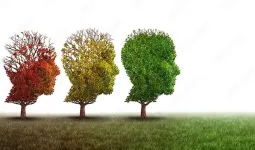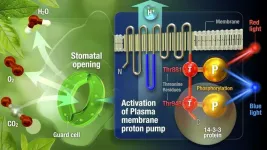(Press-News.org) In a world inundated with a constant stream of new information—notifications, ads, emails, news—we often struggle to prevent our attention from being constantly hijacked by external events. But is it truly within our power to filter and select our perceptions? And why do we find ourselves so easily distracted?
“Exogenous attention, the cognitive process that allows a salient visual stimulus to impose itself on us, is automatic. When a colleague walks past our desk, our attention is diverted from our computer screen despite ourselves,” explains Tal Seidel Malkinson (University of Lorraine), a former postdoc at Paris Brain Institute and now a professor and researcher in neuroscience. “This phenomenon is all too familiar to anyone who tries to stay focused. Yet, the brain mechanisms behind it are still poorly understood.”
Functional MRI or electroencephalogram (EEG) are usually used to study the neural substrate for exogenous attention, but these techniques are limited by poor temporal or spatial resolution. “To track how the brain constructs spatial attention—which involves large and fast neural networks—we needed to record the electrical activity of neurons throughout the cortex and in great detail,” the researcher adds.
As close to neurons as possible
To this end, Malkinson and her colleagues recruited 28 patients who received depth electrodes as part of a pre-surgical assessment for drug-resistant epilepsy. Placed individually for each patient, the electrodes covered about 1,400 contact zones deep in the brain, giving the researchers a detailed view of neural activity during attention tests.
Participants had to look at two boxes separated by a small cross designed to focus their attention. Occasionally, a target appeared in the box on the left or right; the subject had to press a button to signal that they had seen it. Finally, the targets were preceded by peripheral visual cues capable of capturing the subject's attention and announcing where the target was about to appear (valid cue) or the opposite area (invalid cue).
“This protocol is useful for measuring under which conditions the attention is captured by one event or redirected towards another,” Paolo Bartolomeo (Inserm), co-author of the study, describes. “It also makes it possible to measure the subjects' reaction time and understand which visual stimuli the brain is likely to group—to process them either as a single event or as successive events.”
To interpret the highly complex data from the intracerebral recordings, Tal Seidel Malkinson and Jacobo Sitt (Inserm) have developed an unsupervised learning method: an algorithm groups the electrodes that have a similar activity over time to reveal the global dynamics of the studied areas. This approach enables researchers to observe brain activity while reducing the influence of their theoretical preconceptions.
The gradient of attention in action
Their results identified three cortical networks that were successively activated from the back to the front of the brain when the participants' attention was captured by visual stimuli, as if attention were gradually developing in the cortex until the subject's final reaction—in this case, pressing a button.
“There is a continuum of activity in the cortex. In networks identified in the parieto-occipital regions, brain activity first processes visual information. Then, in the frontal regions, it reflects the behavioural response”, Malkinson explains. “We have shown that attention emerges like a bridge between these two poles. In a way, attention connects perception to action!”
“This is the first time the dynamics of exogenous attention networks appear so clearly, as well as their place in the organisation of the cortex”, Bartolomeo says. “Moreover, this work allowed us to observe the neural correlate of inhibition of return—an attentional phenomenon in which a longer reaction time is observed when someone is exposed to visual stimuli in a region of space they already explored, compared with a region of space that is still unknown.”
Inhibition of return is a filter that allows us to ignore familiar visual information automatically. For example, if we are trying to spot a squirrel in a tree, the branches we have examined will no longer be the focus of attention, even if they are waving in the wind. “Inhibition of return probably promotes efficient exploration”, the researcher adds. “It is frequently defective in some patients who have suffered a stroke. Increasing our knowledge of the mechanisms of attention could, in the long run, contribute to treating them better.”
END
Actually, the team from Naturalis Biodiversity Center in the Netherlands was looking for a Tyrannosaurus, that summer of 2013 in Wyoming. Instead, they found a Triceratops: the famous dinosaur with the three horns and the large neck frill. And then they found another one. And another one. And more. The dig turned into a project that would last for more than ten years.
All in all, they dug up 1200 bones and bone fragments, of at least five individuals. A team of professional and volunteer paleontologists ...
Research Highlights:
Nontraditional risk factors for stroke were significantly associated with the development of strokes in adults younger than ages 35 to 45.
Migraine was the most important nontraditional risk factor for stroke among both men and women, according to the study of adults in Colorado.
Embargoed until 4 a.m. CT/5 a.m. ET Tuesday, March 26, 2024
DALLAS, March 26, 2024 — Adults younger than 35- to 45-years old may have a higher risk of developing a stroke from nontraditional risk factors ...
Bethesda, MD (March 26, 2024) – Modeling studies and expert consensus published today in the journals Gastroenterology and Clinical Gastroenterology and Hepatology shed new light on the promise and peril of liquid biopsy (blood tests) for colorectal cancer (CRC) screening that are currently in development.
“Based on their current characteristics, blood tests should not be recommended to replace established colorectal cancer screening tests, since blood tests are neither as effective or cost-effective, ...
One in three birders experiences accessibility challenges to participation in birding, according to Virginia Tech researchers Emily Sinkular and Ashley Dayer.
“I like to think of our research as blending together two previously unconnected fields: disability studies and wildlife recreation,” said Sinkular, a Ph.D. student and lead author of the study published March 26 in the journal Human Dimensions and Wildlife. “There’s been quite a lot of research on disability and lots of research on birding, but very few researchers have combined these two topics together.”
The ...
A global collaborative research group comprising 131 researchers from 105 laboratories across seven countries announces a groundbreaking research paper submitted to eLife. Titled "Large-scale Animal Model Study Uncovers Altered Brain pH and Lactate Levels as a Transdiagnostic Endophenotype of Neuropsychiatric Disorders Involving Cognitive Impairment," the study identifies brain energy metabolism dysfunction leading to altered pH and lactate levels as common hallmarks in numerous animal models of neuropsychiatric and neurodegenerative disorders, such as intellectual disability, autism spectrum disorders, schizophrenia, bipolar disorder, depressive disorders, and Alzheimer’s ...
An orange dwarf star has yielded the tiniest ‘starquakes’ ever recorded, measured by an international team of scientists.
Named Epsilon Indi, the star is the smallest and coolest dwarf star yet observed with solar-like oscillations – “starquakes” like those shown by the Sun. These oscillations provide indirect glimpses of stellar interiors – just as earthquakes tell us about Earth's interior – and so are important sources of information about the makeup of the star.
The measurements ...
When we talk, we often use our hands in addition to words. Gesturing is a phenomenon that has been observed across languages and cultures. Some cultures are typically thought to use more gestures than others.
To find out if the deeply rooted stereotype of Italians gesturing more than other cultures is true, researchers in Sweden have examined the differences in gesture rate and function between Italians and Swedes who were telling a story to a friend.
“We show that Italians do gesture more than Swedes, which was expected,” ...
Researchers at the University of Leeds and Lancaster University in the UK have identified a new potential target for the treatment of Alzheimer’s disease – PDE4B.
Alzheimer's disease is the leading cause of dementia and disability in old age. As the number of people diagnosed with Alzheimer’s disease is on the increase, new treatments are urgently needed to improve the quality of life for people living with the disease.
PDE4B is an enzyme inside cells that breaks down a molecule known as cyclic AMP, which regulates a range of cellular processes. Based on an Australian study that identified the ...
Scientists from Nagoya University have discovered a novel regulatory mechanism that controls the opening of stomata in plants, which is crucial for harnessing solar energy through photosynthesis. The team uncovered the role of phosphorylation at the 881st threonine residue (Thr881) of the plasma membrane proton pump in response to red and blue light in this process. This research opens up possibilities for manipulating plant physiology in specific ways, benefiting agriculture and the environment. The researchers reported their findings in Nature Communications.
“This phosphorylation event, ...
As authorities crack down on illicit drugs, University of South Australia experts have issued an alert on the use of the synthetic stimulant pentylone, as new research finds a 75% increase in detections across Australia.
In a new study as part of the Australian Criminal Intelligence Commission’s National Wastewater Drug Monitoring Program, researchers identified 20 different novel psychoactive substances (NPS) in wastewater treatment plants across Australia (between Feb 22-23) with pentylone detected at every collection site. Other NPS, eutylone and phenibut were also commonly detected.
Pentylone, (street name ‘bath salts’), ...






